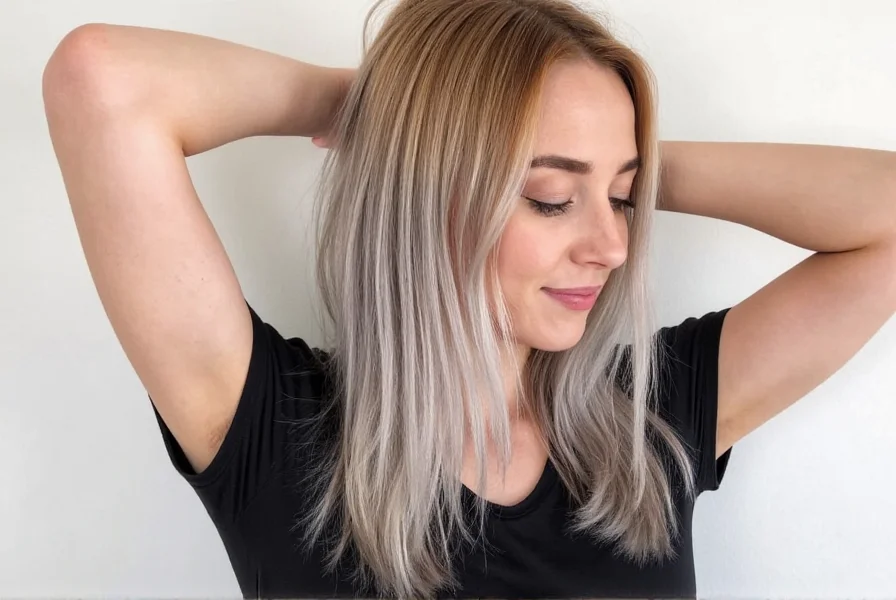Understanding Ginger Grey Hair Color
Ginger grey represents a modern hair coloring technique that artfully blends reddish ginger tones with silvery grey shades. Unlike traditional grey hair that appears flat and ashy, ginger grey incorporates subtle warmth that creates depth and dimension. This color variation has gained significant popularity as people seek more natural-looking alternatives to solid grey or silver hair.
The key to successful ginger grey lies in the precise balance between warm and cool pigments. Too much grey overwhelms the ginger tones, while excessive warmth defeats the purpose of the grey base. Professional colorists typically use a combination of:
- Golden or copper undertones for the ginger element
- Violet-based toners to neutralize unwanted brassiness
- Customized grey pigments that complement the client's natural undertones
| Hair Color Variation | Warmth Level | Best For Natural Hair Colors |
|---|---|---|
| True Ginger Grey | Moderate warmth | Redheads transitioning to grey |
| Copper Grey | High warmth | Light brown or auburn hair |
| Rose Grey | Low warmth | Fair complexions with cool undertones |
Skin Tone Compatibility with Ginger Grey
Your skin's undertone significantly impacts how ginger grey appears on you. The most flattering results occur when the hair color complements rather than competes with your natural complexion.
Warm undertones (typically golden or peachy skin that tans easily) pair exceptionally well with ginger grey. The warmth in the hair color harmonizes with warm skin, creating a cohesive look. People with warm undertones often have:
- Golden or amber eye colors
- Natural hair ranging from strawberry blonde to deep auburn
- Jewelry that looks best in yellow gold
Neutral undertones can successfully wear ginger grey with proper formulation. A skilled colorist will adjust the ratio of warm to cool tones to match your specific complexion. Those with neutral undertones often look good in both silver and gold jewelry.
Cool undertones (typically pink or blue-based skin that burns easily) require careful formulation. The ginger grey must contain sufficient cool elements to prevent clashing with cool skin. Without proper balancing, the warmth can make cool-toned complexions appear sallow.
Natural Hair Color Considerations
Your starting hair color dramatically affects the ginger grey outcome and the complexity of the coloring process:
- Natural redheads transitioning to grey achieve the most seamless ginger grey results. Their hair already contains the necessary pheomelanin (red pigment) that blends beautifully with grey.
- Light to medium brown hair requires careful lifting to remove underlying warmth before applying the ginger grey formula. This process typically needs professional expertise to avoid brassy results.
- Dark brown or black hair presents the greatest challenge. Achieving ginger grey requires significant lightening, which may necessitate multiple salon visits to prevent hair damage.
- Previously colored hair adds complexity, as residual pigments can interact unpredictably with the ginger grey formula.
Maintenance Requirements for Ginger Grey Hair
Ginger grey requires specific care to maintain its balanced appearance between warm and cool tones. The primary challenge is preventing unwanted brassiness while preserving the ginger warmth.
Professional colorists recommend these maintenance practices:
- Use purple or blue shampoo 1-2 times weekly to neutralize brassiness without eliminating all warmth
- Apply color-depositing conditioners with subtle copper tones between salon visits
- Protect hair from sun exposure with UV-protectant products
- Schedule toning appointments every 4-6 weeks to refresh the color balance
- Avoid hot water when washing, as heat can accelerate color fading
Common Ginger Grey Concerns Addressed
Many people considering ginger grey have specific concerns about the color's practicality and appearance:
Will it look natural? When properly formulated for your skin tone and natural hair color, ginger grey appears more natural than solid grey, especially for those with any underlying red pigments in their hair.
How often will I need touch-ups? Root regrowth becomes noticeable faster with ginger grey than with solid colors. Most clients require touch-ups every 4-6 weeks to maintain the seamless blend between natural roots and colored hair.
Can I achieve this at home? While at-home kits exist, professional application yields superior results. The precise balance of warm and cool tones requires expertise to avoid patchy or unnatural results.
Long-Term Ginger Grey Hair Strategy
For those embracing natural greying, ginger grey offers an elegant transition strategy. Rather than fighting grey hair with solid color, ginger grey works with your natural greying process.
The gradual approach involves:
- Starting with subtle ginger highlights in existing grey strands
- Progressively increasing the ginger-grey ratio as more grey appears
- Maintaining consistent toning to preserve the balanced appearance
This method creates a sophisticated, age-appropriate look that appears intentional rather than accidental. Many find this approach reduces the psychological impact of visible greying while maintaining a youthful appearance through the warmth in the color.











 浙公网安备
33010002000092号
浙公网安备
33010002000092号 浙B2-20120091-4
浙B2-20120091-4